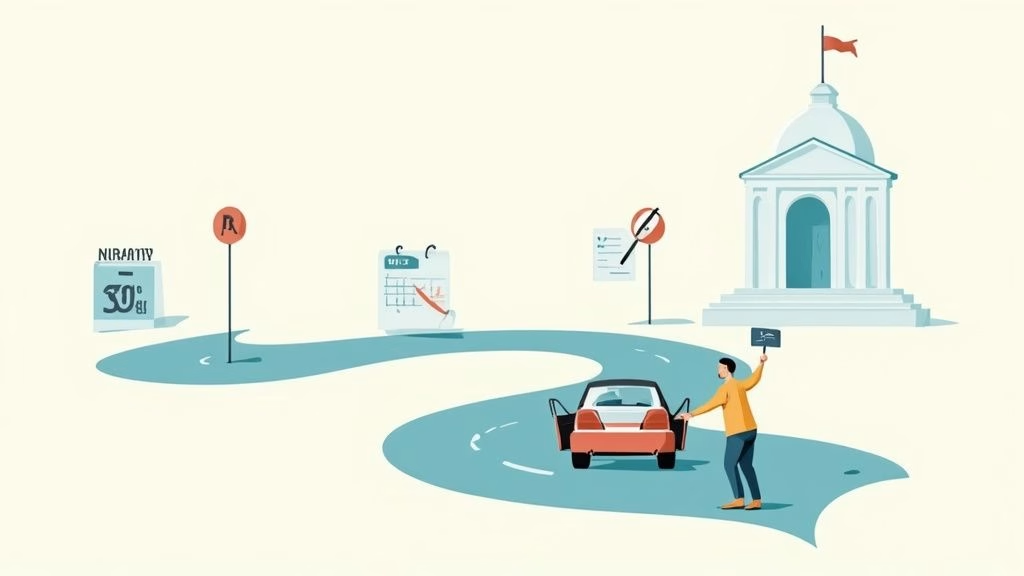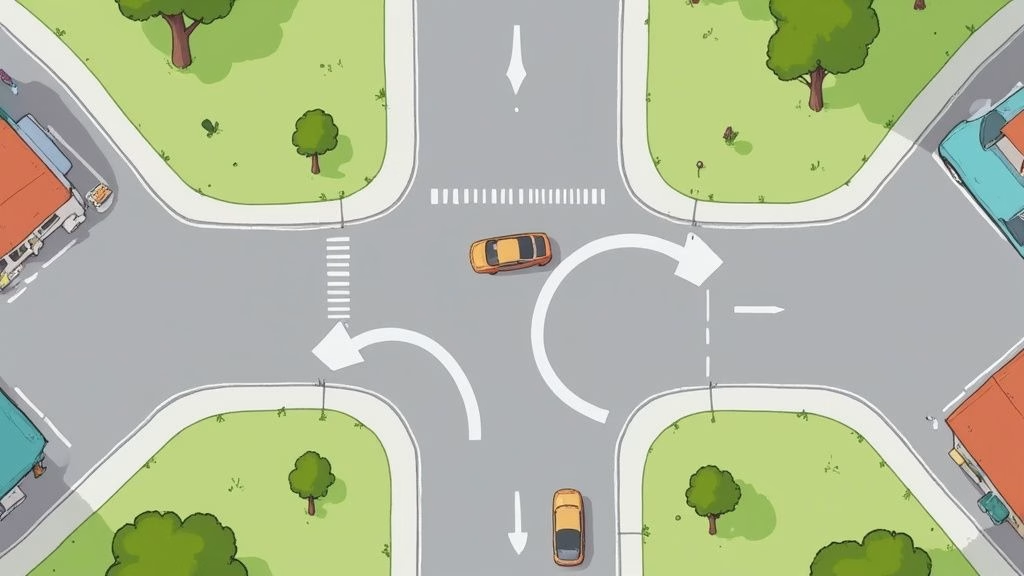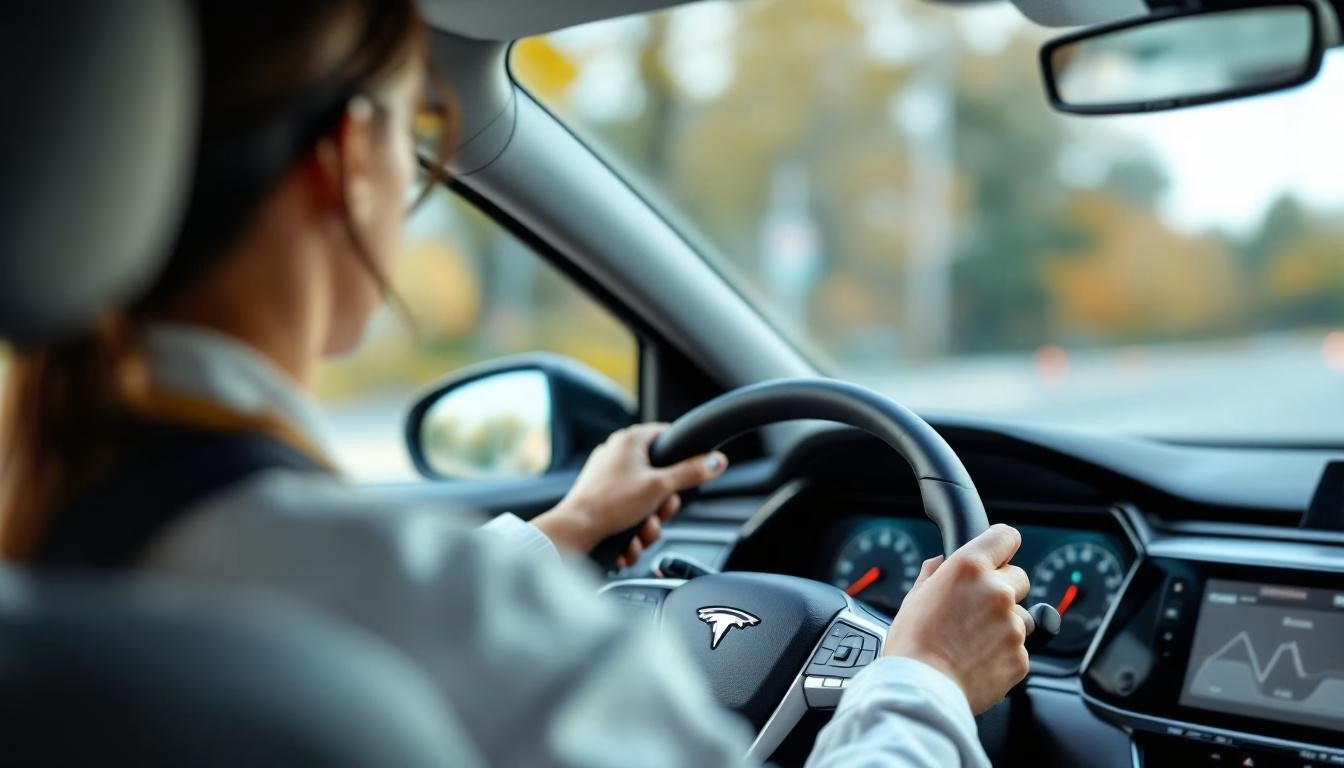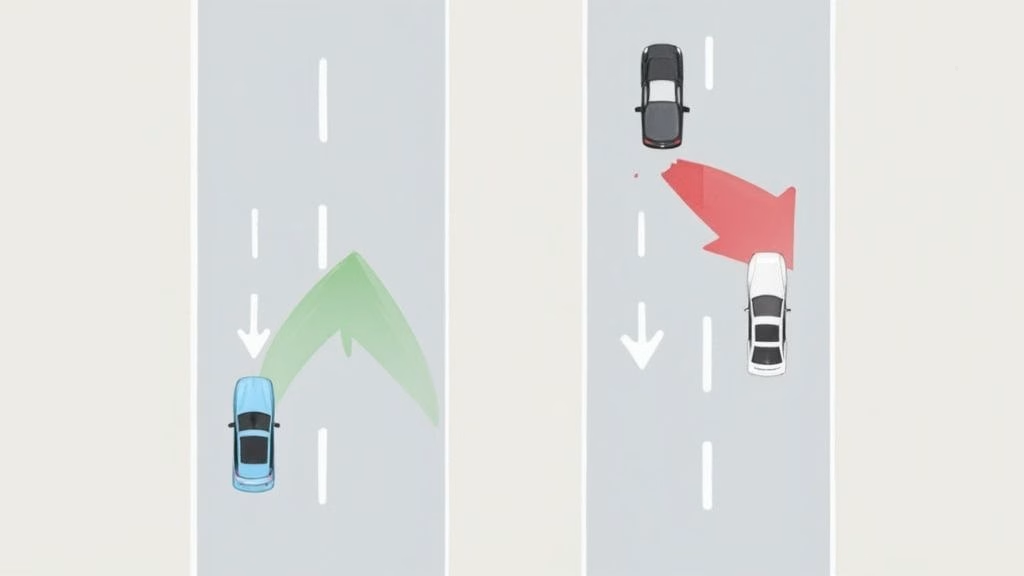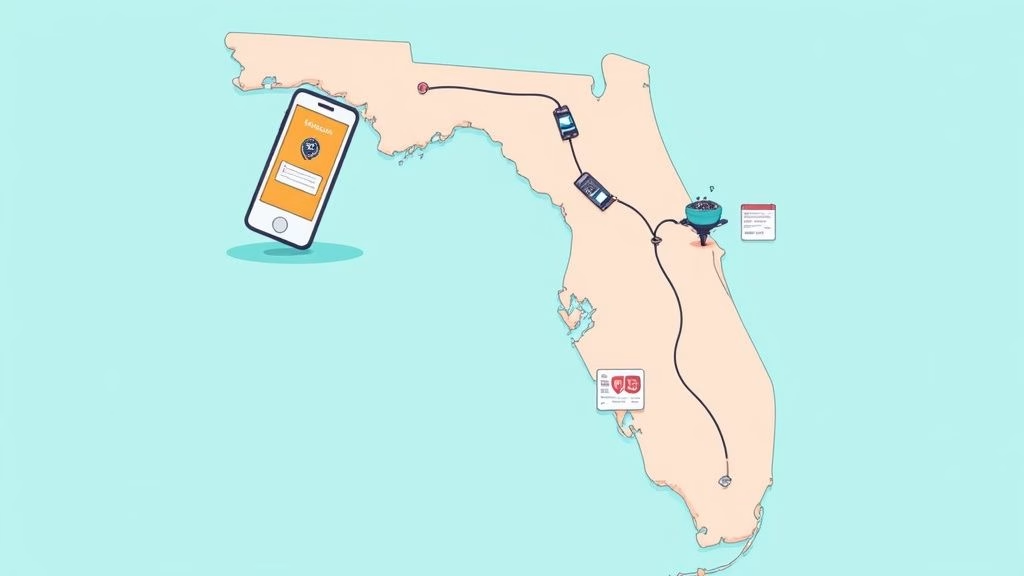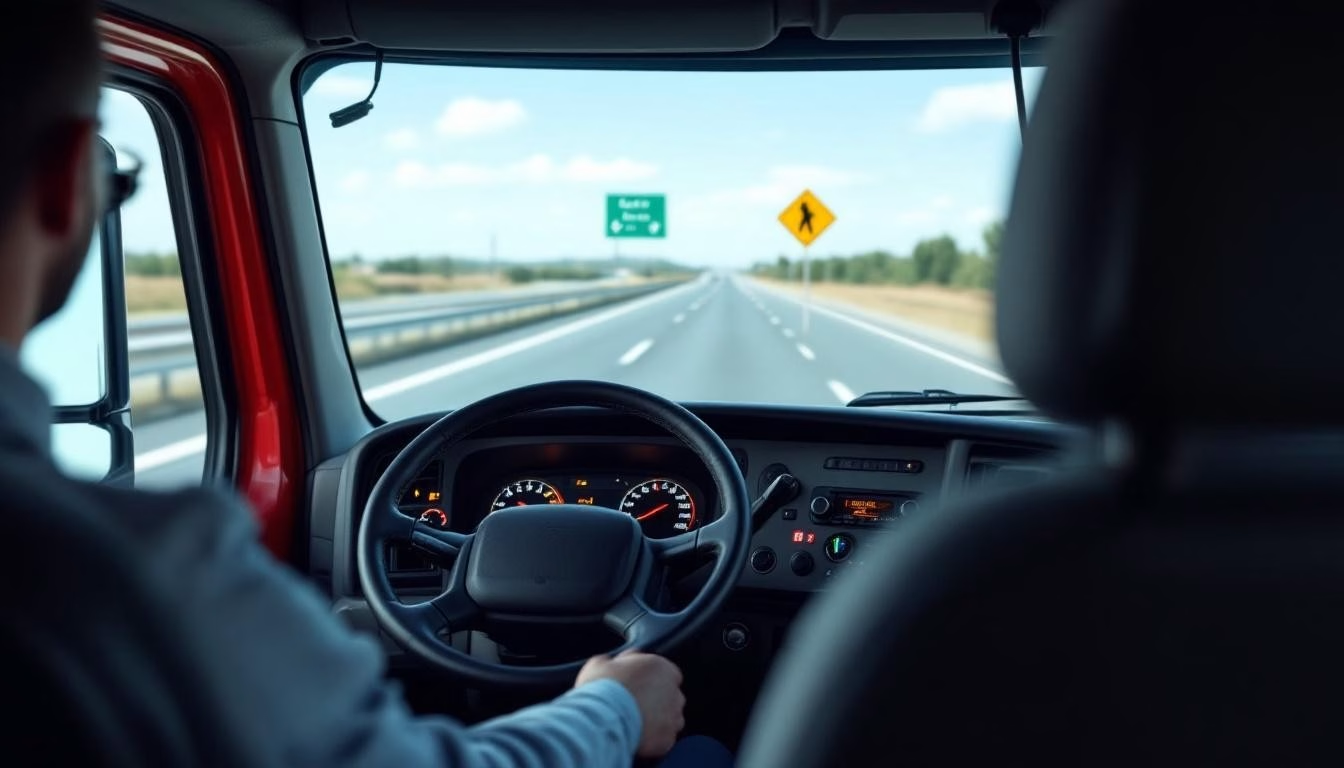Getting a traffic ticket is a frustrating experience, but what you do next is what really counts. That citation isn’t just a bill�it’s a legal notice that demands a response. Typically, you have three main options: pay it, fight it, or go to traffic school. Getting a handle on these choices right away is the first step to successfully navigating the court process.
Your First Steps After Getting a Ticket
Take a deep breath and look closely at that piece of paper. Before you do anything else, read the entire citation. It�s packed with crucial details like the exact violation you’re accused of, the deadline to respond, and the total fine. Missing that deadline is a big deal and can lead to hefty late fees or even a suspended license.
Think of this as a fork in the road. The path you choose now will determine everything that comes next.
Understanding Your Plea Options
Your formal response to the ticket is called a “plea,” which is just legal-speak for how you want to handle the situation. In most places, you have three choices:
- Guilty: You’re admitting you did what the ticket says. You’ll pay the fine, and the violation almost always adds points to your driving record.
- Not Guilty: This means you believe you are innocent and want to challenge the ticket. You’re telling the court you want your day to present your side of the story.
- No Contest (Nolo Contendere): This is a bit of a middle ground. You’re not admitting guilt, but you are accepting the penalty. The key benefit here is that a “no contest” plea usually can’t be used against you as an admission of fault if there’s a related civil lawsuit, like one for a car accident.
If your ticket was issued after a collision, it’s a good idea to understand what to do after a car accident to ensure you’re protected, as the outcome of your ticket could affect other legal matters.
The infographic below gives a great visual overview of the journey from getting the ticket to making your plea and preparing for court.
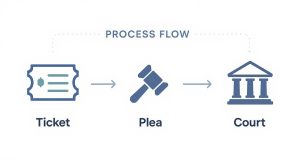
As you can see, your plea is the pivotal moment that decides whether you simply pay a fine or move forward to the courtroom.
To give you a clearer picture, here’s a simplified breakdown of the core stages you can anticipate.
What to Expect in Traffic Court A Quick Overview
| Stage | What Happens | Key Objective |
|---|---|---|
| Ticket Issued | You receive a citation from a law enforcement officer. | Understand the violation, fine, and your deadline to respond. |
| Plea Entry | You officially respond by pleading guilty, not guilty, or no contest. | Formally notify the court of your intentions. |
| Arraignment | Your first court appearance where you enter your plea before a judge. | Make your plea official and get a trial date if you plead not guilty. |
| Trial | You and the officer present evidence and testimony. | Argue your case to get the ticket dismissed or the charges reduced. |
| Verdict | The judge makes a final decision on your case. | Receive the final outcome: guilty or not guilty. |
| Sentencing | If found guilty, the judge assigns penalties (fines, traffic school, etc.). | Understand and fulfill the court’s requirements. |
This table maps out the general flow, but remember that every case is unique.
Making an Informed Decision
Before you rush to a decision, think about the long-term effects on your driving record and your insurance premiums. Racking up points can cause your rates to skyrocket. It�s smart to know where you stand, so consider learning how to check your driving record.
A common mistake is just paying the fine to get it over with. Remember, paying the fine is the same as pleading guilty. This often puts points on your license, which can lead to higher insurance rates for up to three years.
For many minor offenses, you might have the option to attend a state-approved traffic school. This is often a great choice because it can get the ticket dismissed and keep points off your record, which helps keep your insurance costs down. Take a moment to weigh the cost of the fine against the long-term financial hit before you make your final call.
Getting Your Case Ready for Court
Winning a traffic court case rarely happens by just showing up. A strong defense is built long before you ever step into the courtroom. When you plead “not guilty,” you’re telling the court you have a story to tell and the evidence to back it up. Let’s walk through how to build that case so you can arrive feeling confident, not just hopeful.
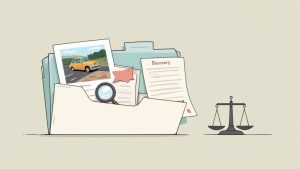
Think of it like being a detective. Your mission is to gather every piece of information that supports your side of the story. The more solid proof you have, the more convincing your argument will be.
Start Collecting Your Evidence
Evidence is simply anything that helps prove your point. Your first step should be to round up every bit of physical or digital proof you can find that relates to the ticket. You’re trying to paint a vivid, accurate picture for the judge.
Here are a few examples of evidence that can make a real difference:
- Photos and Videos: If it’s safe, go back to the location of the traffic stop. Snap photos of anything that helps your case�a hidden stop sign, a broken traffic light, or even hazardous road conditions. If you have a dashcam, that footage is pure gold, offering an unbiased look at what really happened.
- Witnesses: Did anyone see the incident? A witness can be incredibly powerful. Make sure to get their name and phone number. Ask them if they’d be willing to show up in court or, at the very least, sign a written statement describing what they saw.
- Maps and Diagrams: Sometimes the best way to explain a complex situation is with a visual aid. A simple, hand-drawn map of the intersection or a quick printout from Google Maps can make your explanation crystal clear to the judge.
The Secret Weapon: The Discovery Process
You’ve gathered your own evidence, but what about the evidence the officer has against you? You have a right to see it, and this formal process is called discovery. Honestly, it’s one of the smartest things you can do.
When you file a discovery request, you can get your hands on some crucial documents:
- The Officer’s Notes: This lets you see exactly what the officer wrote down in the moments after pulling you over.
- Calibration Logs: If you got a speeding ticket, you can ask for the maintenance records for the radar or laser gun. Was it working properly?
- Video Footage: Many police cars and officers have cameras. This footage can either confirm or completely contradict the officer’s version of events.
Discovery is your chance to see the other team�s playbook before the game even starts. If you find a detail in the officer’s notes that doesn’t match what they say in court, you’ve just found a powerful way to challenge their credibility.
Should You Get a Traffic Lawyer?
This is a big question. While you absolutely have the right to represent yourself, sometimes a professional can make all the difference, especially when the stakes are high.
It’s probably a good idea to hire an attorney if:
- The charge is serious, like a DUI or reckless driving.
- You’re close to getting your license suspended from too many points.
- Your job depends on a clean driving record (think commercial truck drivers).
For a minor speeding ticket, many people do just fine on their own. But if a conviction could have serious consequences, the cost of a lawyer is often a wise investment. To get a better feel for your options, take a look at our detailed guide on how to contest a traffic ticket.
Remember, traffic courts are incredibly busy. The 2025 Court Statistics Report for California, for example, shows that traffic cases are a huge chunk of the workload in their superior courts. With the right preparation, you can make sure your case stands out and gets the fair hearing it deserves.
Your Day in Court: What to Expect When You Arrive
Walking into a courtroom for the first time can be intimidating. It feels formal, a little surreal, and nothing like what you see on TV. But knowing the script ahead of time can take the edge off, helping you stay focused on what really matters: presenting your case clearly and confidently.
Let’s walk through what the day will actually look like, from the moment you park your car to when the judge calls your name.
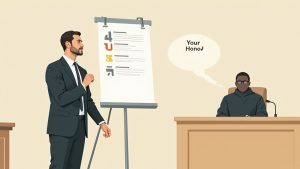
Remember, the way you present yourself speaks volumes before you even say a word. A little respect and preparation go a very long way in this environment.
Getting Settled In Before Your Case is Called
Your day at court really begins before you even step inside. Plan to arrive at least 30 minutes early. Seriously. This isn’t the time to cut it close. You�ll need that extra cushion for finding a parking spot, getting through building security, and locating the right courtroom, all without that frantic, last-minute rush.
Getting there early also has a strategic advantage: you can sit in the gallery and watch other cases. This is an invaluable opportunity to get a feel for the judge’s personality and the general flow of the proceedings.
How you dress is your first impression. You don’t need a three-piece suit, but you absolutely need to look like you take the situation seriously. Think business casual.
- Good choices: Slacks and a collared shirt, a simple blouse, or a conservative dress are all safe bets. Make sure your shoes are clean and closed-toe.
- What to leave at home: Avoid shorts, graphic t-shirts, hats, and flip-flops. Anything you�d wear to the beach or the gym is a definite no.
Once you find your courtroom, find a seat, and completely silence your phone. Not on vibrate�off. Use this quiet time to go over your notes one last time and mentally prepare.
Courtroom Etiquette 101: It’s all about respect. Always address the judge as “Your Honor.” Stand up whenever you’re speaking to them and when they enter or leave the room. These small gestures show you understand the gravity of the setting.
The Typical Flow of a Traffic Court Hearing
Traffic court is built for efficiency. The judge has a long list of cases (the “docket”) to get through, so things move in a structured, predictable way. It’s far less dramatic than a courtroom drama.
To give you a clear picture, here�s a quick rundown of how most hearings unfold.
The Order of Events in a Traffic Court Hearing
This table outlines the typical sequence you’ll experience from the moment the session begins.
| Stage | What Happens | Your Role |
|---|---|---|
| 1. The Docket Call | The clerk or judge will read a list of names for that session’s cases. | Listen for your name and clearly say “Present” or “Here” so they know you’ve arrived. |
| 2. Guilty Pleas | The judge often deals with anyone pleading guilty first to speed things up. | Wait patiently. Your case will be called later. |
| 3. Your Case is Called | The judge will call your name for your trial. | Approach the designated table at the front of the courtroom. The judge will ask you to confirm your “not guilty” plea. |
| 4. The Officer Testifies | The police officer who issued the ticket will be sworn in and will state their version of events. | Listen intently and take notes on anything you want to ask about later. Do not interrupt. |
| 5. Your Cross-Examination | You get to ask the officer questions about their testimony. | Ask specific, fact-based questions to find inconsistencies or clarify details. Avoid arguing. |
| 6. Your Testimony | It’s your turn. You’ll be sworn in to present your side of the story and any evidence. | Speak clearly, stick to the facts, and calmly present your argument. |
Knowing the sequence helps you stay calm and prepared for what’s next.
Fully understanding all of your traffic ticket options is a huge asset, as the judge might offer alternatives you weren’t aware of. Ultimately, your poise, preparation, and respectful attitude are just as crucial as any evidence you bring.
Understanding Court Outcomes and Penalties
After you’ve made your case and the officer has given their testimony, the courtroom goes quiet. This is the moment where all your preparation comes down to the judge’s final decision. Knowing what that ruling means is crucial for figuring out what to do next.
The outcomes are usually pretty straightforward, but the consequences can be vastly different. Let’s walk through the most common verdicts you’ll hear.
Guilty Verdict Consequences
If the judge finds you “guilty,” it means they believe the evidence shows you committed the violation. This isn’t just about paying a fine; it kicks off a chain reaction that can follow you for years.
Here are the most common penalties you’ll face:
- Fines and Court Costs: You’ll have to pay the fine for the violation, plus a handful of administrative court fees that can really pump up the total amount.
- Points on Your License: The Florida DMV will add points to your driving record. Racking up too many points in a set period leads straight to a license suspension.
- Increased Insurance Premiums: Your insurance company will see the violation on your record, which almost always means higher rates for the next three to five years.
A guilty verdict is a lot more than a one-time payment. It’s like a rock tossed in a pond�the fine is the splash, but the points and insurance hikes are the ripples that keep spreading, costing you a lot more over time.
Not Guilty or Dismissal
Hearing the words “not guilty” or “case dismissed” is the goal. It�s a total win. This means the court has found you’re not responsible for the violation.
When your case is dismissed or you’re found not guilty, it means:
- No Fines: You owe nothing. No fines, no court costs.
- No Points: Your driving record stays clean.
- No Insurance Impact: Your insurance company has no reason to raise your rates because of this ticket.
This outcome is a clean slate. As far as this ticket is concerned, you can walk away and not look back.
Middle Ground Rulings
Sometimes, the judge’s decision isn’t a simple guilty or not guilty. They might offer a different kind of resolution, especially if your violation was minor or if you have a good driving history.
One common alternative is getting the charge reduced. A speeding ticket, for example, is a moving violation. The judge might agree to knock it down to a non-moving violation, like “defective equipment.” This is a huge win, since non-moving violations don’t add points to your license.
Another possibility is an order to complete a driver improvement course. Finish the class, and the ticket often gets dismissed entirely. If you want to explore your options, you can learn more about how to reduce the impact of a traffic ticket and keep your record clean.
What to Do After the Judge’s Ruling
The judge banging the gavel might feel like the end of the movie, but you�re not quite at the credits yet. What you do in the moments right after the ruling is crucial for closing out your case and making sure there are no surprise sequels.
Think of it as the final lap. Whether you won or lost, you need to know the next steps to officially put this ticket in your rearview mirror.
If You Were Found Guilty
A guilty verdict isn’t just a decision; it’s a new to-do list from the court. Ignoring these tasks is a surefire way to turn a small problem into a big one, complete with late fees, extra penalties, and maybe even a license suspension.
Here�s what you need to tackle right away:
- Pay Your Fines: The court will give you the exact amount you owe and a firm deadline. Circle that date on your calendar. Many courts have online payment systems now, which makes this part much easier.
- Sign Up for Traffic School: If the judge ordered a driver improvement course, don’t wait. Get enrolled and make sure you know the deadline to submit your completion certificate to the court.
- Check Your Driving Record: Give it a few weeks, then pull a copy of your official driving record. You just want to make sure the points (if any) were added correctly and there are no errors.
Procrastination is your enemy here. Court deadlines are not suggestions. Missing one could trigger a whole new set of penalties that are often way worse than the original ticket.
Courts are actually getting better at handling this process. We’re seeing a rise in self-service systems for traffic violations, part of a global market valued at around $136 million in 2024. This tech is all about making the system more efficient for everyone involved. You can discover more insights about this growing technology and its future on 24marketreports.com.
If You Won Your Case
A “not guilty” verdict or a dismissal? Fantastic! That’s the best outcome you could have hoped for. The heavy lifting is over for you. No fines to pay, no points on your license from this ticket.
Your only job now is to get proof. Ask the court clerk for a copy of the record that shows the case was dismissed or that you were found not guilty. It’s a good idea to keep this document in your personal files, just in case anything about the ticket ever comes up again.
Thinking About an Appeal
What happens if you feel the judge got it wrong on a point of law? You usually have the right to appeal the decision, but you need to understand what that really means.
An appeal isn’t a do-over where you get to re-argue the facts of your case. It�s a formal claim that a serious legal mistake was made during your hearing, and that this mistake changed the outcome. This is a tough road to go down�it can be complex and expensive.
If you’re even considering an appeal, your very next step should be to talk to a traffic attorney. They can tell you if you actually have solid legal grounds to move forward.
Got Questions About Traffic Court? We’ve Got Answers.
Walking into traffic court can feel like stepping into the unknown, and a lot of “what ifs” probably pop into your head. Getting clear answers to the most common questions before your court date can make a world of difference, calming your nerves and helping you walk in with a solid plan.
Let’s break down the questions we hear all the time. Think of this as your personal FAQ for navigating the process so there are no surprises on your big day.
Do I Really Need a Lawyer for a Traffic Ticket?
This is the big one, and the honest answer is: it depends. You absolutely have the right to represent yourself, and for a simple speeding ticket, many people do just fine on their own.
However, you should seriously think about hiring a lawyer if your situation is more complex. It’s probably a smart move if:
- The ticket is for a serious violation like reckless driving or anything involving an accident.
- You�re in danger of a license suspension because you�ve already racked up too many points.
- Your job is on the line. For commercial drivers, a clean record isn’t just a nice-to-have, it’s a necessity.
An experienced local traffic attorney brings a lot to the table. They understand the court’s quirks, know the prosecutors and judges, and can often negotiate a better deal than you could on your own, potentially getting the charges reduced or even dismissed.
What Happens If the Cop Is a No-Show?
Ah, the old “cop doesn’t show up, you walk free” myth. While it’s true that this can lead to a dismissal, you should never bank on it. Always, always show up to court prepared to fight your ticket as if the officer is sitting in the front row.
If the officer who ticketed you doesn’t appear, one of two things will likely happen:
- Case Dismissed: The judge might dismiss the case right then and there. The officer is the state’s key witness, and without them, they can’t prove their case.
- Case Continued: The prosecutor could ask the judge to reschedule the hearing, and the judge might agree. This gives them another chance to have the officer appear.
Relying on an officer’s absence is a huge gamble. Your best bet is to build a solid defense based on the facts of your case.
Can’t I Just Take Traffic School and Be Done With It?
For many minor violations in Florida, the answer is a resounding yes! If you’re eligible, you can elect to complete a Basic Driver Improvement (BDI) course. This is a fantastic option because it keeps the points from ever going on your license, which is key to stopping your insurance rates from skyrocketing.
A “no contest” plea (or nolo contendere) is a bit different from pleading “guilty.” Pleading guilty is a straight-up admission that you did it. A no contest plea means you accept the penalty, but you aren’t formally admitting guilt. This is a subtle but crucial legal distinction, especially if there was an accident that could lead to a civil lawsuit later.
Just remember, you usually have to officially choose this option and pay your fines with the county clerk before your scheduled court date. You can check your ticket or the clerk of court’s website to see if you qualify.
Ready to keep your driving record clean? At BDISchool, our state-approved online Basic Driver Improvement course is the fastest and most convenient way to handle your ticket. Enroll today at https://bdischool.com and take control of your driving future.

